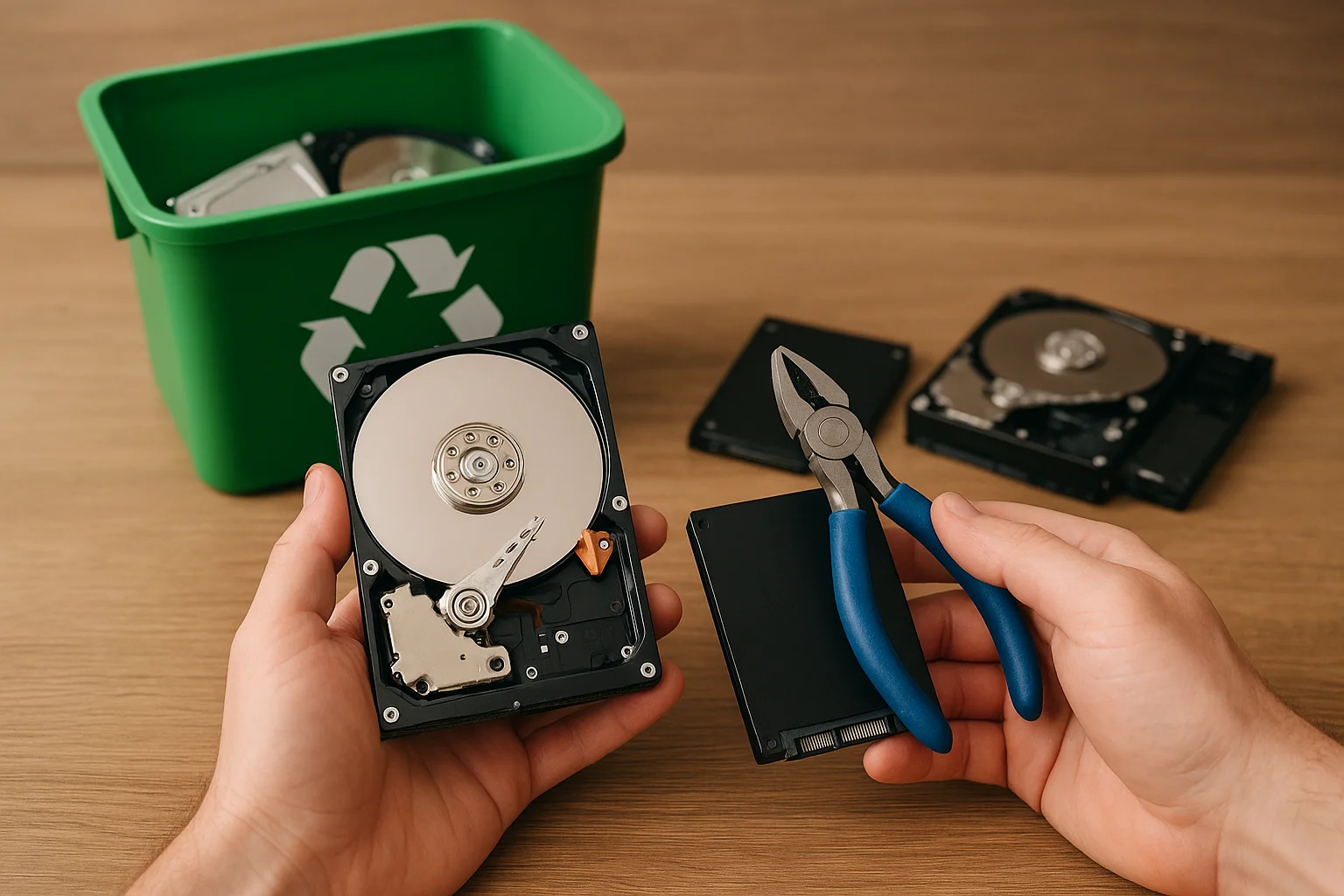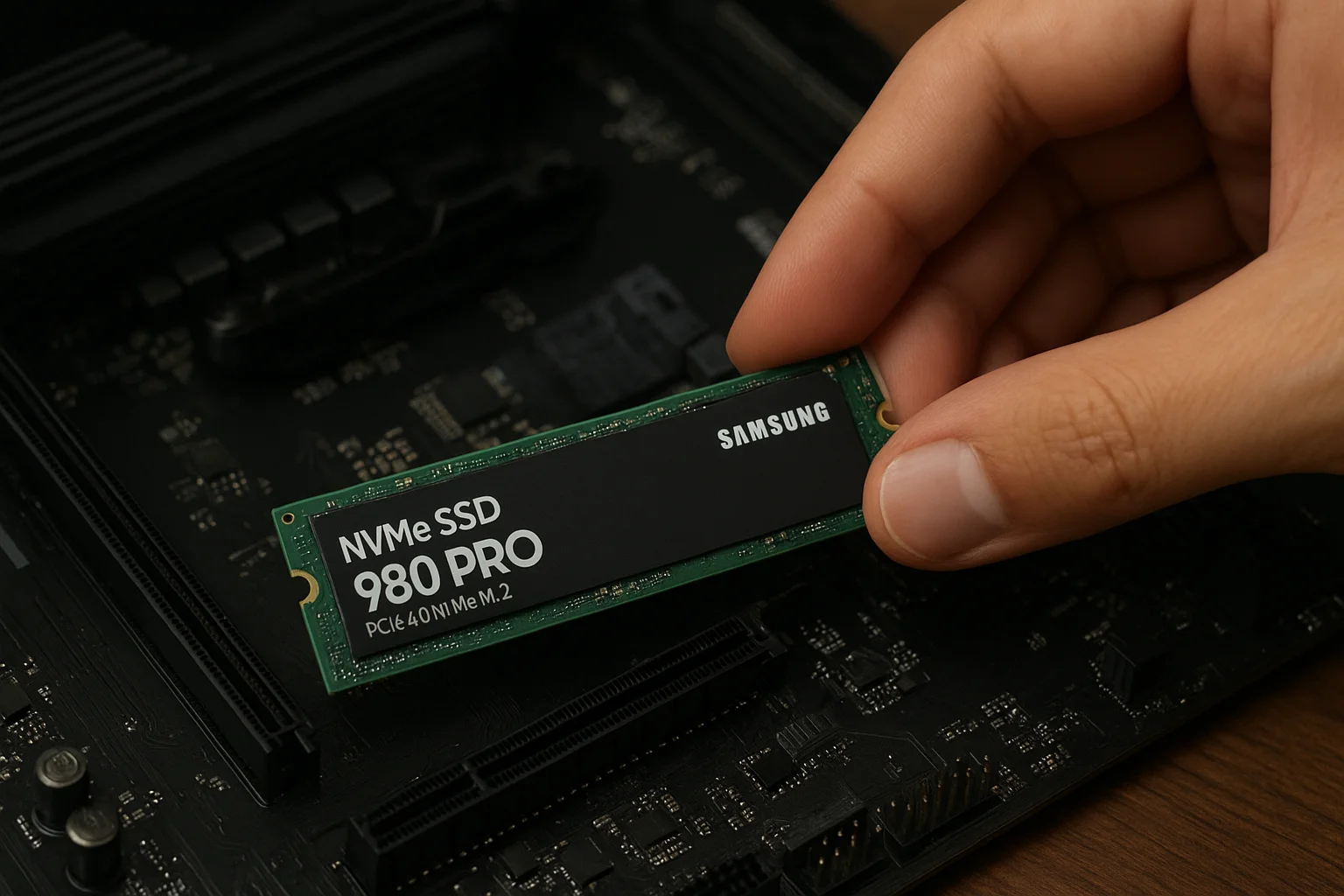Why Proper Recycling of Hard Drives and SSDs Matters
Recycling old hard drives and SSDs is essential to prevent data breaches and environmental harm. Hard drives and SSDs contain sensitive personal or business information that can be recovered even after simple deletion. Improper disposal exposes this data to potential theft, putting both individuals and organizations at risk.
From an environmental standpoint, storage devices are made of materials such as rare metals, plastics, and electronic components that can be harmful if released into landfills. Metals like lead, cadmium, and mercury can leach into the soil and water, while plastics can take hundreds of years to degrade, contributing to long-term pollution.
Recycling these devices through certified programs ensures that valuable materials like copper, aluminum, and gold are recovered and reused, reducing the need for new mining and lowering the environmental footprint. Additionally, proper recycling processes safely handle hazardous components, minimizing the risk of toxic exposure to humans and wildlife.
Finally, responsible recycling of hard drives and SSDs helps organizations comply with data protection laws and industry regulations. Many regions require secure disposal of electronic storage, and following proper recycling procedures can protect against legal and financial penalties.
Data Security First: How to Safely Erase Your Drives
Before recycling a hard drive or SSD, ensuring that all data is completely erased is critical. Simple deletion or formatting is not enough, as specialized recovery software can often restore files. The first step is to use dedicated data wiping tools that comply with recognized standards, such as DoD 5220.22-M or NIST 800-88, which overwrite data multiple times to make recovery virtually impossible.
For hard drives, methods such as disk wiping software or full disk encryption followed by secure deletion are effective. These techniques systematically overwrite every sector of the drive, ensuring sensitive information like passwords, financial records, and personal files cannot be retrieved.
SSDs require special consideration because of their internal wear-leveling algorithms. Standard overwriting may not cover all memory cells, so using manufacturer-provided secure erase utilities or commands like ATA Secure Erase is recommended. These tools are designed to fully reset the SSD to its factory state without leaving residual data.
In addition to software-based methods, maintaining a verified deletion process is important. This may include checking the drive after erasure using recovery software to confirm no files remain accessible. For organizations, keeping a deletion log or certificate of data destruction can provide proof of compliance with data protection regulations and internal security policies.
Combining the right tools with careful verification ensures that sensitive information is thoroughly removed, giving peace of mind before the drive moves on to recycling or resale.
Physical Destruction vs. Software Wiping: What Works Best
When it comes to ensuring data cannot be recovered from old hard drives and SSDs, two main approaches are commonly used: physical destruction and software wiping. Both methods have their advantages and limitations, and understanding these differences helps determine the best approach for your situation.
Software wiping involves using specialized tools to overwrite all data on the drive. Effective software can perform multiple passes, replacing existing data with random patterns to prevent recovery. This method is particularly useful for drives that are still functional and may be repurposed or resold. Modern SSDs, however, require careful attention because their wear-leveling algorithms can leave some memory cells untouched, making manufacturer-provided secure erase utilities a safer option.
Physical destruction completely destroys the storage medium, making data recovery impossible. Methods include shredding, degaussing, drilling, or crushing the drive. This approach is often preferred for highly sensitive data or when drives are damaged or no longer functional. Physical destruction guarantees that even advanced forensic tools cannot retrieve any information.
Choosing between these methods depends on your priorities. Software wiping is ideal if you plan to reuse or donate the drive while still protecting your data. Physical destruction is best when data is extremely sensitive, regulatory compliance is required, or the drive is at the end of its life. In many professional environments, organizations often combine both approaches: first performing a secure software wipe, then physically destroying the drive to ensure maximum data security.
Recycling Electronics: Local vs. National Options
When it comes to recycling hard drives and SSDs, choosing between local and national recycling programs can impact both convenience and reliability. Local options often include municipal e-waste drop-off centers, electronics retailers, or community collection events. These programs are typically easy to access and allow you to personally verify that your devices are being handled responsibly.
Local recyclers may offer on-site data destruction services or accept drives for secure transport to certified facilities. This can provide peace of mind, especially for individuals or small businesses concerned about data security. Additionally, supporting local programs can help reduce transportation emissions and contribute to your community’s sustainability efforts.
National recycling programs, on the other hand, are usually run by large organizations with multiple certified processing centers. They often provide mail-in options with pre-paid shipping labels, making it convenient for businesses or individuals with multiple devices or limited local access. National programs frequently maintain strict compliance with environmental and data protection regulations, ensuring that hazardous components are safely managed and valuable materials are recovered efficiently.
When deciding between local and national options, it is important to consider convenience, security, and certification. Checking for recognized certifications such as R2, e-Stewards, or ISO 14001 can confirm that the recycler follows responsible practices, regardless of the program’s scale. Combining secure transport, proper documentation, and verified processing helps ensure that your old storage devices are recycled in a safe and environmentally responsible manner.
Environmental Benefits of Recycling Storage Devices
Recycling hard drives and SSDs has a significant positive impact on the environment. These devices contain materials such as rare earth metals, aluminum, copper, and gold that can be recovered and reused, reducing the need for new mining operations. Mining and refining these materials consumes large amounts of energy and water, and often produces hazardous waste. By recycling, we minimize these environmental costs.
Storage devices also include components like plastics and circuit boards that can persist in landfills for decades if not properly managed. Recycling prevents these materials from contributing to soil and water pollution. Additionally, hazardous elements such as lead, cadmium, and mercury, present in small quantities in some drives, are safely handled and contained in certified recycling facilities, protecting ecosystems and human health.
Another benefit of recycling electronics is the reduction of carbon emissions. Manufacturing new drives requires extracting raw materials, producing components, and assembling devices, all of which generate greenhouse gases. Reusing metals and other materials from recycled devices lowers energy consumption and reduces emissions associated with production.
By participating in responsible recycling programs, individuals and organizations contribute to a circular economy, where materials are reused rather than discarded, promoting sustainability and reducing the environmental footprint of electronic waste.
Common Mistakes to Avoid When Recycling Drives
One of the most frequent mistakes is failing to securely erase data before recycling. Simply deleting files or formatting the drive does not remove information completely, leaving it vulnerable to recovery. Using inadequate wiping methods or neglecting verification can put sensitive personal or business data at risk.
Another common error is choosing uncertified recyclers or informal collection services. Not all recycling centers follow proper environmental and data protection standards, which can result in hazardous materials being mishandled or valuable components being discarded instead of recovered. Always verify certifications such as R2, e-Stewards, or ISO 14001.
Many people also overlook the condition of the drive. Attempting to recycle a damaged or malfunctioning SSD or hard drive without proper handling can lead to physical hazards like battery leakage, sharp edges, or exposure to toxic substances. Ensuring drives are packaged safely and handled correctly prevents injury and environmental contamination.
Additionally, neglecting documentation is a common oversight. For businesses especially, keeping records of data destruction and recycling is essential for regulatory compliance and internal audits. Without proper documentation, organizations may face legal or financial consequences if data recovery is later attempted from discarded devices.
Finally, underestimating the importance of timing can be a mistake. Storing old drives indefinitely or delaying recycling increases the risk of data breaches or environmental harm. Prompt, responsible disposal ensures both data security and sustainable resource management.

